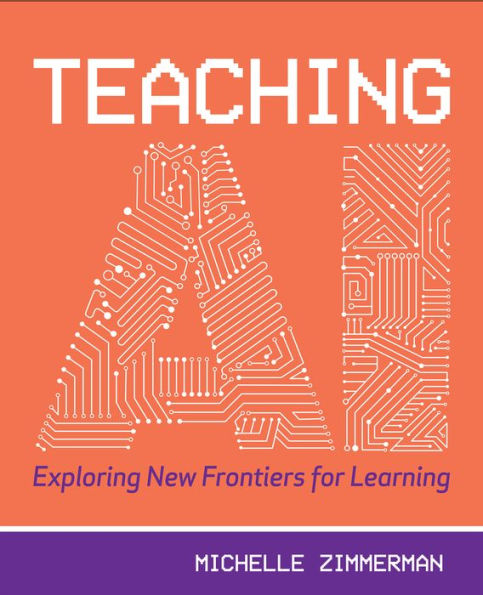

Paperback
-
PICK UP IN STORECheck Availability at Nearby Stores
Available within 2 business hours
Related collections and offers
Overview
For many, artificial intelligence, or AI, may seem like science fiction, or inherently overwhelming. The reality is that AI is already being applied in industry and, for many of us, in our daily lives as well. A better understanding of AI can help you make informed decisions in the classroom that will impact the future of your students.
Drawing from a broad variety of expert voices from countries including Australia, Japan, and South Africa, as well as educators from around the world and underrepresented student voices, this book explores some of the ways AI can improve education. These include educating learners about AI, teaching them about living in a world where they will be surrounded by AI and helping educators understand how they can use AI to augment human ability.
Each chapter offers activities and questions to help you deepen your understanding, try out new concepts and reflect on the information presented. Links to media artifacts from trusted sources will help make your learning experience more dynamic while also providing additional resources to use in your classroom.
This book:
- Offers a unique approach to the topic, with chapter opening scenes, case studies, and featured student voices.
- Discusses a variety of ways to teach students about AI, through design thinking, project-based learning and STEM connections.
- Includes lesson ideas, activities and tools for exploring AI with your students.
- Includes references to films and other media you can use in class to start discussions on AI or inspire design thinking and STEM projects.
In Teaching AI, you’ll learn what AI is, how it works and how to use it to better prepare students in a world with increased human-computer interaction.
Audience: K-12 educators, tech coordinators, teacher educators

Product Details
| ISBN-13: | 9781564847058 |
|---|---|
| Publisher: | International Society for Technology in Education |
| Publication date: | 12/13/2018 |
| Pages: | 216 |
| Product dimensions: | 7.40(w) x 9.10(h) x 0.60(d) |
About the Author
Table of Contents
Introduction xv
Who Is This Book For? xx
If You Are New to Al xx
If You Are Experienced with Al xxi
Why Should You Read This Book? xxii
The Perspectives xxiii
The Approach xxiii
ISTE Standards for Students xxiv
Equitable and Ethical xxiv
What You Can Expect to Find in This Book xxv
Chapter 1 What Is Al? 1
Questioning Human-Computer Interaction 1
What Al Is-and Isn't 5
Personal Assistants 5
Chatbots 7
Language Translators 7
Facial Recognition 8
Accessibility 9
Autonomous Vehicles 9
Creative Applications for Al 10
Al and What It Means to Be Human 10
History of Al 14
Beating Humans at Their Own Games 15
The Current A1 Season: How Al is Being Used 16
Al with Interdisciplinary Teams in the Medical Field 17
IBM Watson 18
MIA Learning 19
Chapter 2 Preparing Students for the Future 21
Conversations with Experts 21
Comparing Human Learning and AI 25
How Al Machine Learning Works 31
Making Machine Learning More Complex 33
Implications for Future Careers in Which Al Is Used 35
Pixar Animation Studios 35
Material Sciences and Engineering 37
Defense Field 38
A DARPA for Education 40
Accessibility Through Biomedical Advances 41
Ethical Considerations 43
ISTE Standards for Students and Teachers 44
Chapter 3 Approaches to Teaching with Al 47
Way of Tea and Design Thinking 47
Integrating AI into Existing Curriculum 53
Applying What We Know about Al to Education 55
Al Language and Vocabulary 56
Flexibility 56
Ethics 57
Culture 57
Teaching Within a Rapidly Advancing Field 58
"High-Touch and High-Tech" Learning 60
Design Thinking 61
Divergent Thinking for Design 62
Visual Thinking: Strategies to Support Design Thinking in Machine Learning 66
Steam and the Arts 68
Teaching with Al in the Context of STEM Learning 71
STEM and Storytelling with Seeds 73
How STEM Was Seen in This Unit 77
ISTE Standards for Students Demonstrated 77
Next Generation Science Standards Addressed 78
Project-based Learning 78
Where Do I Start? 81
Nullius in Verba: Take Nobody's Word for It 82
Chapter 4 How Al Can Support Student Learning 87
Expanding Horizons with Storytelling and Al 87
Foundations for Human-Computer Interaction and STEM Learning 89
Learning as a Sociocultural Process 90
Storytelling and Preparing For Al 92
Personalized Learning 94
Differentiated Instruction 97
Robotics 101
Diversity and Gender Equity in STEM Careers 102
STEM Is for Everyone 103
Reflecting on Diversity in STEM Careers 105
Hair and Diversity in STEM Careers 107
Chapter 5 How AI Can Support Teachers 109
Work Smarter, Not Harder 109
Automating Tasks to Free Up Educator Time 113
Human Aspects of Sociocultural Learning That Make a Difference 113
Data Mining 114
Assessment 115
Success Supported by Augmentation from AI, Machine Learning, and Human interaction 117
Working Out a Roadmap for Smarter, Not Harder 118
Arts, Music, and AI 119
Mixing Tools for Music Class 119
Portfolio Tools for Art Assessment 120
Apprenticeship in the Digital Age 121
AI for Augmentation to Support Educators 122
What Teachers Can Add to AI Augmentation 123
The Importance of Teachers: Physical Education as an Example of AI Augmentation 125
Developing Chatbots 126
How Educators Around the World Are Considering Their Role in Educational Al 128
Hidekazu Shoto, Japan 128
Phuti Ragophala, South Africa 128
Nam Thanh Ngo, Vietnam 129
Aggeliki Pappa, Greece 129
Chapter 6 Ethical Considerations 131
A Sick Baby and the Boy Who Did Not Hide Behind a Newspaper 131
The Human Side of AI 134
Loss of Control 135
Loss of Privacy 135
Online privacy 136
Facial and Voice Recognition 136
Cyberbullying 136
Cyberattacks 137
The Law and the Legal System 138
Gaming and Rogue AI 143
Changes in the Job Market 145
Conclusion: What We Have to Offer: Esse Quam Videri 149
Imperfections and Failures 151
Glossary 153
References 163
ISTE Standards For Students 175
Index 179
